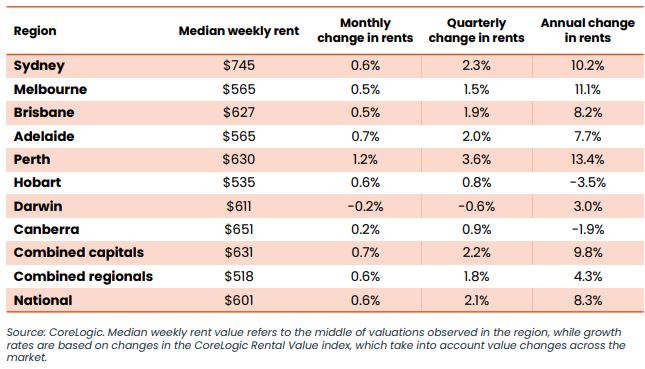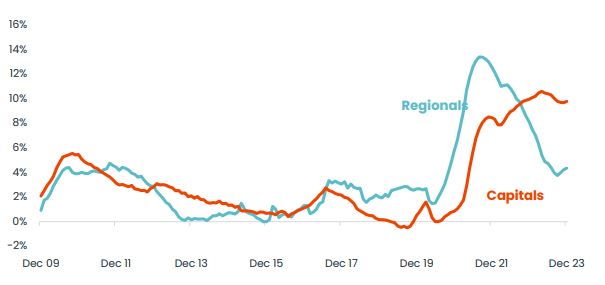Median weekly rents break records, crashing through $600 barrier
Renters in Australia are paying more than ever before, and the prospects of a rapid turnaround in their fortunes appear remote.
The pace of rental growth may be slowing but for the 31 per cent of Australian households who are renting their homes, the latest national record-breaking statistic will still sting.
The median rent paid across the country has just ticked up to $601, the highest figure ever.
Annual rent increases for the year were up 8.3 per cent, compared to an overall national inflation rate of 4.3 per cent.
CoreLogic’s Rental Market Update, released Tuesday (23 January), revealed that yearly rental expenses had soared by more than $8,000 since August 2020 to $31,252 a year.
Given wages have largely stalled and certainly lagged inflation by a large amount in that time, it is a massive hit to struggling renters across the nation.
Throughout the 2010s the average annual rental growth rate was 2.0 per cent. In the past three calendar years it has averaged 9.1 per cent each year.
Eliza Owen, Head of Research Australia, CoreLogic, cited three primary reasons for the red-hot rental market.
“There has been a notable decline in the average household size from late 2020, partly driven by a reduction in share housing – meaning more dwellings were needed even when population growth was close to zero in 2021.
“Secondly, a rapid increase in the Australian population from late-2022 as international border restrictions were lifted.
“And then there was a temporary shock to investment housing activity between May 2022 and February 2023 as interest rates rose, and while investor activity has picked up markedly since, there is still a lot of catch up required in establishing new rentals.”
She added that the reduction in social housing supply as a portion of all dwellings over the decades has placed more pressure on the private rental market, as has a declining rate of home ownership.
The (Senate rental crisis) inquiry’s final report produced no collective recommendations whatsoever and was a waste of taxpayers’ money.
- Nicola McDougall, Property Investment Professionals of Australia
Home owners are deemed to be categorised as in mortgage or rental stress when more than 30 per cent of their income goes on those outgoings.
In a poignant indicator of just how savage the past few years have been for renters, the portion of gross median household income required to service median rent rose from 26.7 per cent of income in March 2020 to 31.0 per cent in September last year.
Being in rental stress is the new average.
While a far higher portion of median income is required to service a new mortgage, renters tend to be on lower incomes. The latest data from the Australian Bureau of Statistics suggests median gross household income was 41.8 per cent lower across renting households than owner occupiers with a mortgage.
Rents are rising almost everywhere.
Canberra and Hobart were the only markets to see a decline in rent values through 2023, at -1.9 per cent and -3.5 per cent, respectively.
The proportion of available rental properties across the country has halved since the pandemic onset. The national vacancy rate inched up 0.09 percentage points (ppt) from October’s record low in December to 1.12 per cent but it’s a long way from what is typically seen as normal conditions, within the 2-3 per cent range.
According to PropTrack, Melbourne experienced the greatest tightening in conditions of any market in 2023 as vacancies declined 0.33 ppt throughout the year, followed by Sydney and regional Queensland.
Vacancy rates remain below 1 per cent in Perth, Brisbane and Adelaide.
Perth and Adelaide remain the tightest rental markets in the country, with vacancy rates holding below 0.75 per cent, indicating the lack of stock is at critical levels, though throughout 2023 conditions eased very slightly, with vacancies increasing 0.02 ppt and 0.06 ppt, respectively.
Antonia Mercorella, Real Estate Institute of Queensland’s CEO, said rental properties were still too thin on the ground to provide comfortable choice for Queensland’s sizeable rental population.
“What we’ve seen over the course of the year, is a rental property pool that’s insufficient and under incredible strain,” Ms Mercorella said.
“It’s not necessarily that rentals are impossible to find everywhere in our state, it’s the imbalance between the sheer demand and shortage of supply of rentals at certain price points and locations that’s out of kilter.
“Many are finding it’s a lot less hassle to renew their existing lease than to risk re-entering the fast-moving market, especially if they are attached to their area.”
Senate rent inquiry lambasted
The prospects of the housing crisis being resolved in the near-term appear remote and may well worsen.
Australia commenced construction of just 23,058 new houses in the September Quarter 2023, the weakest quarter in over a decade and down by 21.6 per cent on the same quarter last year.
This ABS data released last week, reveals there were 103,707 detached houses that commenced construction in the 12 months to September 2023, down by 17.0 per cent on the 124,940 commenced in the previous 12-month period.
HIA’s Senior Economist, Tom Devitt, said it points to a slow start to National Cabinet’s ambition to build 1.2 million homes over the next five years, starting mid-2024.
“Since the RBA’s first cash rate increase in May 2022, sales of new homes have tumbled. A number of earlier projects are also being cancelled, with banks withdrawing finance in the face of soaring building costs and shrinking homebuyer borrowing power.
“This lack of new work entering the construction pipeline is expected to produce a trough in new house commencements in 2024, when Australia will start construction on just 95,400 new houses, the weakest year in over a decade.
“Total detached and multi-unit commencements are at less than 180,000 in 2024, far below the 240,000 per annum required to meet National Cabinet’s target.”
A Senate Inquiry into the worsening rental crisis in Australia has done little to appease those calling for answers from government.
“The inquiry’s final report produced no collective recommendations whatsoever and was a waste of taxpayers’ money,” according to Nicola McDougall, Chair, Property Investment Professionals of Australia (PIPA).
“Outcomes from the National Cabinet in August last year indicated that the cabinet supported a move towards a national standard of no more than one rent increase per year for a tenant in the same property across fixed and ongoing agreements.
“That is a significantly different viewpoint than the inquiry chair, from the Australian Greens, recommendation to freeze rents for two years as well as capping rents at two per cent every two years.”
It seems renters won’t be holding their breath, just their wallets, waiting for any rental price relief.























